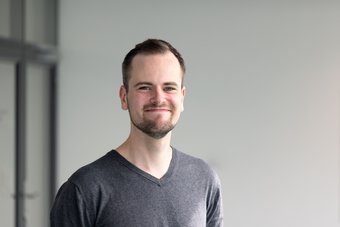
Service Crystallography Lab in Basel

A 10-minute read
Running a service crystallography lab often requires meeting two contradictory conditions: ensuring reliable, high-throughput measurements and being open to innovations. At the University of Basel, Dr. Alessandro Prescimone balances these two conditions with three diffractometers, each dedicated to a different scope: high-throughput samples, difficult structures, or teaching. With these, Alessandro optimizes time and experimental conditions for each user group: internal departments, industry users, and students who are involved in crystallography courses.
On a cold day in 2018, DECTRIS and representatives from the company Excillum went to Basel to meet Dr. Alessandro Prescimone, a new crystallography lab manager, and see his custom-made, single-crystal instrument : a gorgeous STOE STADIVARI diffractometer, equipped with a PILATUS3 R CdTe 300K detector and a Ga source MetalJet D2. Installed in 2016, this diffractometer has been something of a workhorse for the service crystallography lab. And there was a lot of work to do! Chemistry and Pharmaceutical Science departments, as well as industry users, were sending over 200 samples per year for analysis, and the instrument has also been used for teaching crystallography.
Then, on an equally cold day in 2022, Alessandro shared the news: “We have a new diffractometer!” Although the new diffractometer is wonderful news per se, there is another aspect to the story: how does this affect the processes in the lab?
“Our customized STADIVARI diffractometer was an innovative project. It was commissioned in 2016 by my predecessor, Dr. Markus Neuburger, who recognized the benefit of combining a powerful Ga source with a CdTe-based detector that features high efficiency and a large-area sensor. The diffractometer has been the perfect solution for small crystals and difficult structures, and it allowed us to perform measurements with exposure times that are three times lower”, explains Alessandro.
This instrumental setup was a win-win scenario for both necessary conditions: high-throughput measurements and an innovative approach. Decreased exposure times meant shorter measurement times, while the combination of source and detector was able to deal with even the smallest crystals and the weakest signals. However, time management was not necessarily easy: high-throughput measurements are short but involve a lot of samples, difficult samples require longer (uninterrupted) measurements, and teaching also requires lots of time…
Matters became more difficult when the other single-crystal diffractometer became too outdated for efficient use. So, Alessandro managed to get a new diffractometer–and, with it, new laboratory processes. The new diffractometer is to be used for high-throughput measurements, while the custom-made machine will take its (rightfully earned) place as a solution for difficult crystals and structures.
“The experience with the custom-made STADIVARI was great, so the new high-throughput instrument is also a StadiVari, but it is equipped with a Cu source and an EIGER2 R 1M detector”, says Alessandro.

Compared to the custom-made diffractometer, this one features lower flux and smaller detector pixels. However, the two instruments share some similarities: Cu and Ga energies are rather close, and the areas of the EIGER2 R 1M and the PILATUS3 CdTe 300K are comparable, which makes comparative studies feasible. “The new STADIVARI performs fast measurements and provides high-quality data. If a structure determination is problematic, the crystal is measured again with the custom-made machine; then, we can dedicate more time (and more flux!) to the problem. This way, we can streamline our processes and ensure that each user gets excellent data quality in a very short time”, says Alessandro.
Along with supporting researchers from the University and the industry, Alessandro is involved in teaching, as part of official crystallography courses that are offered at the University of Basel . Each year, he has about thirty students, ranging from the Bachelor’s level to PhD. In the last two years, the courses were held mostly virtually, so he is hoping to welcome students into the lab again. “I am happy that I can also use the new STADIVARI for teaching. For the students, this diffractometer is a bit more straightforward. And for me, it is easier to divide the machine time between teaching and high-throughput measurements than to interrupt a long-duration experiment”, he says.
The third diffractometer in Alessandro’s lab is a STOE Stadi powder diffractometer, equipped with a Cu source and a MYTHEN2 R 1K detector. This instrument extends the capacity of the lab to micro- and nanocrystalline samples.
Although Alessandro is supporting his users in both measurement and Rietveld refinement of the data, this is not the end of his interests. Recently, an electron diffractometer was installed not too far away, at the Switzerland Innovation Park Basel Area and Alessandro is hoping to dive into electron diffraction, too. “As any service crystallography lab does, we like warranties, reliability, and long life cycles of diffractometers and processes. But, we are also at the forefront of innovations, which is both a stroke of good fortune and a high responsibility to continuously learn and improve”, he concludes.
About Alessandro Prescimone
Alessandro started his studies at the University of Pisa, where he graduated from the Chemistry department. He then obtained his PhD in the field of high-pressure crystallography at the University of Edinburgh. In 2014, he joined the University of Basel as an expert crystallographer and began managing the service crystallography lab. Alessandro has published over 100 peer-reviewed publications in the fields of chemistry and crystallography.
About STOE
STOE STOE, originally founded in 1887, to manufacture equipment for the optical analysis of crystals, has always been a pioneer in powder and single crystal X-ray diffraction. STOE is based in Darmstadt, Germany. STOE is the partner in X-Ray Diffraction to crystallographers, chemists, material scientists and pharmacists all over the world.
About Excillium
Excillum develops and produces powerful, laboratory-scale X-ray sources. Located in Sweden, Excillum offers the microfus sources MetalJet, based on its metal-jet-anode technology; and NanoTube, based on advanced electron optics and the latest tungsten-diamond transmission target technology.




